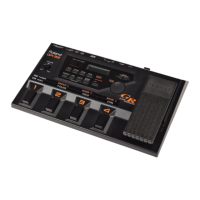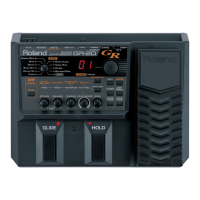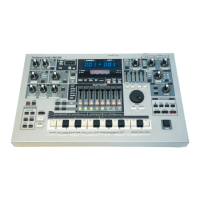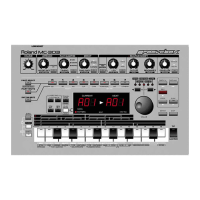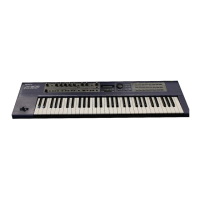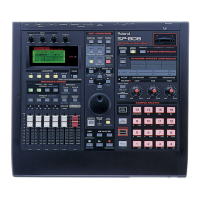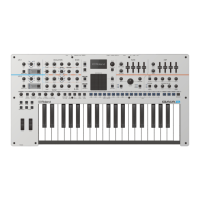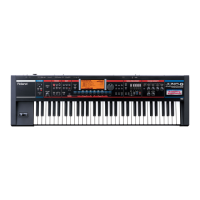Changing Sound Placement
(PAN)
You can give the first and second tones different audi-
tory placement, for example placing the two tones left
and right in a stereo arrangement.
Also, changing the settings changes the placement of
the sound, so you can do things like set the placement
of each string in irregular patterns. This is done with
the COMMON “PAN” setting.
<Setting and Saving Sound Placement>
1. Select the patch whose placement you want to set,
and press [EDIT/PLAY] to go into the Edit mode.
2. Set the EDIT TARGET dial to COMMON, and the
PARAMETER SELECT dial to “C” (PAN).
3. Press the [+] and [-] buttons to change the display.
(Display shows -50 to +50, 1-6, 6-1, o-E, E-o, rnd,
1.rd, 2.rd, ALt, 1.AL, or 2.AL.)
For more on the effects that you can get with each
setting, refer to ◆ below.)
4. When you get it set to sound the way you like,
switch the PARAMETER SELECT dial to “WRITE
PATCH?”, and press the [+] and [-] buttons simul-
taneously to write the patch.
➼
When saving to another patch number, before step 4,
turn the PARAMETER SELECT dial to “WRITE
TO...”, and use the [+] and [-] buttons to designate a
patch number as the destination.
◆ PAN Values (Display) and the Effects of
Their Settings
-50 to 0 to 50
With the setting at “0,” all sound is placed in the
center. By changing the values in a range of -50 to
50, panning changes continuously, and with the
first tone 50 places it completely to the right, and -
50 all the way to the left. Conversely, setting the
second to -50 places the sound to the left, and a
setting of 50, the sound is placed to the right.
Therefore, by setting a patch using both tones to a
value near 50 or -50, you can make it a patch with
a rich, widespread stereo sound.
1-6, 6-1
With this setting each string is panned separately.
When you select 1-6, the strings’s sounds are
placed in sequence from the left, string 1, string 2,
..., string 6. Conversely, with 6-1, the opposite
arrangement is set, i.e. string 6, string 5, all the
way to string 1. (Example of a patch using this:
E52.)
o-E, E-o (odd, Even)
This setting separates odd- and even-numbered
strings, and places the left and right. With o-E, the
odd-numbered strings (1, 3, and 5) are panned left,
and the even-numbered strings (2, 4, and 6)
panned right. With E-o, left and right are
switched, but the effect is the same. (Example of a
patch using this: G84.)
rnd, 1.rd, 2.rd (rnd/rd = random)
The sound placement of the first and second tones
changes randomly. (Example of a patch using this:
G82.) “1.rd” and “2.rd” set only the first or second
tone respectively to this random placement. The
other tone is placed in the center.
ALt, 1.AL, 2.AL (ALt/AL = alternate)
The placement of both the first and second tones
switches repeatedly between left and right For
patches having only one tone playing, the tone
plays crosses back and forth from both left and
right. With a patch using both tones, but with the
first tone to the right and the second tone to the
left, this gives a special stereo effect that differs
from that you get with the “rnd” (random) setting
(Example of a patch using this: E81.)
“1.AL” and “2.AL” set only the first or second tone
respectively to this alternate placement. The other
tone is placed in the center.
✽
Pan settings have no effect on the internal reverb and
chorus.
✽
You can get the panning effects using these of pan set-
tings only with equipment that can produce stereo
sound connected with two cables, or when using stereo
headphones. Furthermore, while you can use the MIX
OUT [R] as a second stereo headphone jack, please
understand that the left and right output of [L] will be
reversed.
39
5

